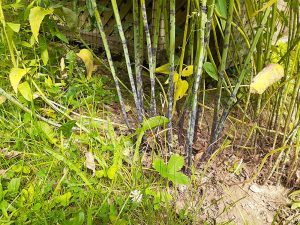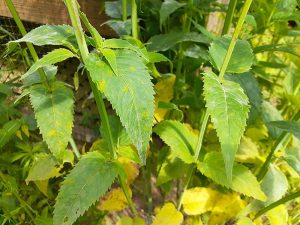What’s wrong with my bee balm?
Question:
Last year, I bought some bee balm from a vendor at the farmers market and planted it. It is growing well, but it has magenta “stains” on the stalks. The lower leaves are turning yellow, and there are some white and yellow spots on some of the upper leaves. The spots eventually turn brown.
What is wrong with the bee balm, and what should I do about it? I prefer organic solutions if possible.
Answer:
Kate Garland, Horticultural Professional
I cannot tell what might be causing the black stains on the stems, but the leaves clearly have powdery mildew, a very common fungal disease on Monarda (bee balm). Here’s an excerpt from this fact sheet, Yard and Garden: Bee Balm from Iowa State.
“Cultural practices can reduce the severity of powdery mildew. When planting bee balms, select a site that receives at least six hours of direct sun each day and space plants 2 to 2½ feet apart. Move plants growing in partial shade to a sunny location. Divide bee balms every two to three years to prevent overcrowding. Remove and destroy disease-infested plant debris in fall. If cultural practices fail, fungicides can also be used to control powdery mildew.
The best way for home gardeners to avoid the annoying problem of powdery mildew is to select and plant mildew resistant varieties. Varieties that possess good to excellent resistance to powdery mildew include ‘Marshall’s Delight’ (bright pink flowers), ‘Jacob Cline’ (deep red flowers), Grand Marshall™ (fuschia-purple flowers) and ‘Raspberry Wine’ (wine red flowers).”
Are you able to rub the stains off the lower stems? The plant disease diagnostician wondered if it might be something simply living on the surface of the plant and not necessarily causing a disease.


